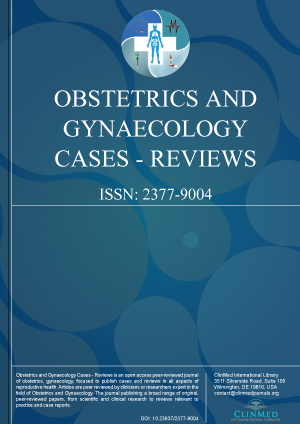Open Access DOI:10.23937/2377-9004/1410064
Left Vaginal Obstruction and Complex Left Uterine Horn Communication in a 12 Year Old Female
Barry E. Perlman, Amy S. Dhesi, Gerson Weiss
Article Type: Case Report | First Published: October 29, 2015
Obstructive Mullerian duct anomalies are an infrequently encountered clinical problem. The use of imaging and surgical exploration allowed for diagnosis and treatment of symptoms of a complex obstructive mullerian anomaly. We present a case of a 12 year old female with a history of intermittent lower abdominal pain and absent left kidney who was found to have an obstructed left vagina and complex left uterine horn communications resulting in hematocolpos, hematometra, and endometriosis....
Open Access DOI:10.23937/2377-9004/1410063
Turner Syndrome and Infertility: A Review of Literature
Emine Demirel, Emre Ekmekci, Zeynep Soyman and Sefa Kelekci
Article Type: Review Article | First Published: October 28, 2015
Fertility of women with Turner Syndrome is now being more interested due to the new improvements in assisted reproductive techniques. Turner Syndrome is characterized by the premature atresia of ovarian follicules. Atresia starts at intrauterine period and continues till all ovarian follicules go to atresia. The time of this period changes from patient to patient. Also Turner Syndrome is related with higher risks in pregnancy. These include higher incidence of spontaneous abortion, fetal anomaly...
Open Access DOI:10.23937/2377-9004/1410062
Placental Abruption Diagnosed by the Lab Technician
L MacDonald, F Waterson, S Marshall and A Cope
Article Type: Case Report | First Published: September 30, 2015
Placental abruption is the separation of the placenta from the uterus. Diagnosis of placental abruption is largely a diagnosis of exclusion and ultrasound is not diagnostic. A case of a placental abruption diagnosed by the presence of two blood types in the group and save sample is presented. A thorough search of the relevant databases would suggest that this is the first reported case of such....
Open Access DOI:10.23937/2377-9004/1410061
Primary Umbilical Endometrioma: A Case Report
Lim Leek Mei and Mickael Hoong Farn Weng
Article Type: Case Report | First Published: September 30, 2015
We report a case of primary umbilical endometrioma. She was a 41year old lady, para 1+1 with a background history of type2 diabetes mellitus, hypertension and a previous uneventful Caesarean section in 2005. She was subfertile since then. She presented with scanty painless bleeding from the umbilicus for past 5 months which coincided with her menses. The bleed would start a few days before her menses and ceased by day two, in small amount and painless. Her cycles were regular with normal flow a...
Open Access DOI:10.23937/2377-9004/1410059
Case Report: Gestational Diabetes Mellitus: 2 Cases Diagnosed and Treated Using IADPSG Criteria. The Debate Goes On
Alejandra Duran Rodriguez-Hervada, Amparo Sabate Garcia, Consuelo Aunon Pereda, Carla Assaf-Balut, Miguel A Rubio, Nuria Izquierdo Mendez, Noelia Perez Perez, Miguel A Herraiz Martinez, and Alfonso L Calle-Pascual
Article Type: Case Report | First Published: September 28, 2015
Gestational Diabetes Mellitus (GDM) is an important public health problem, given its high prevalence and its association with adverse maternal and fetal outcomes. Recent evidence has confirmed that the risk of adverse outcomes is a continuum, increasing as maternal blood glucose levels rise. Furthermore, women with prior GDM are a high-risk group for the future development of diabetes, metabolic syndrome, and cardiovascular disease....
Open Access DOI:10.23937/2377-9004/1410058
Ovarian Stromal Hyperthecosis and Hyperandrogenemia Refractory to Hormonal Suppression
Gregory M Gressel, Natalia Buza, Shirley M McCarthy and Pinar H Kodaman
Article Type: Case Report | First Published: September 26, 2015
Ovarian stromal hyperthecosis (OSH) is an uncommon clinical entity. According to the 2014 WHO classification of gynecologic tumors, it has been documented in one-third of patients older than age 55 years of age in autopsy studies. This disorder usually presents in the second or third decade of life with menstrual irregularity as well as signs of virilization. Presentation in the post-menopausal period is less common, but has been reported....

